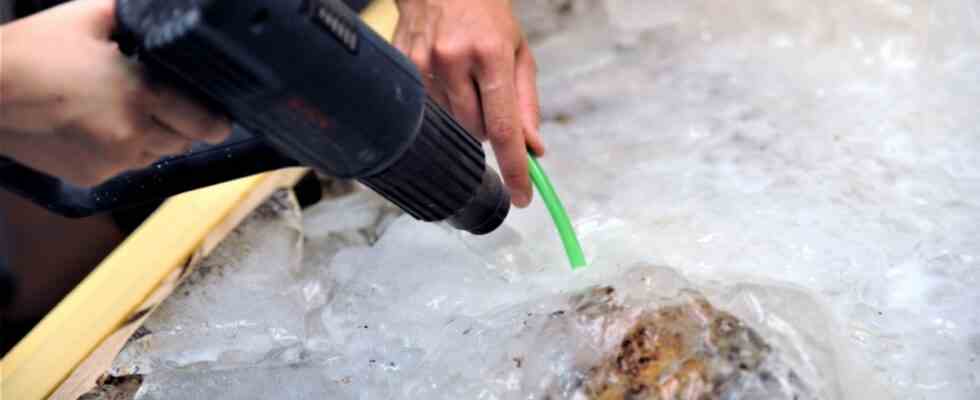Undoubtedly, the ice is one of archaeologists’ most faithful assistants. The body of Ötzi, the world-famous glacier mummy, would never have been so well preserved if the eternal ice of the Ötztal Alps had not preserved it for thousands of years. And who knows what sensational finds will come to light on the glaciers in the future. Irrespective of this, archeology itself now uses the icy cold to use it as an aid in the salvaging of archaeological finds. This method has now been used for the first time in the Swabian town of Tussenhausen (district of Unterallgäu), and the pilot project is currently running very successfully.
The child’s grave was recovered in Tussenhausen, Swabia, last October.
(Photo: Bavarian State Office for the Preservation of Monuments)
After recovery, all layers of the tomb and the earth block were flash frozen with liquid nitrogen.
(Photo: Bavarian State Office for the Preservation of Monuments)
Last October, a team of archaeologists in Tussenhausen recovered an approximately 1,300-year-old child’s grave. Inside was the skeleton of a boy who was probably buried with a dog in the 7th century. Since the child still had milk teeth, it could hardly have been more than ten years old when it died. Such a grave find is still largely part of the archaeological routine, but in this case the type of salvage caused a sensation. Because the burial chamber was lifted out of the ground in one block, together with the remains of the boy and the earth. The shock freezing technique developed by the Bavarian State Office for the Preservation of Monuments was used for the first time. In order to protect the grave during transport from the site of discovery to the Bamberg depot, it was wetted layer by layer with water and then everything was shock-frozen with liquid nitrogen. Freezing should prevent the finds from shifting and getting damaged.
But now, as the authorities announced in a touch of poetry, the so-called ice prince is starting to sweat. This is because restorers are melting the ice off in a controlled manner this week, using hot air guns and soldering irons, among other things. The deep-frozen child’s grave is thus thawed. Since no sediments penetrated the interior during the salvage, the finds are in excellent condition for a grave from this period.
The condensation water is discharged via a suction cup
After the block with the child’s skeleton was stored in a freezer for several months, “the nickname of our little ice prince will soon be obsolete,” announced the State Office for the Preservation of Monuments. “Our restoration team prepared this process meticulously,” explained General Curator Mathias Pfeil, head of the state office. For the thawing process, the block weighing 800 kilograms was brought into a room whose humidity can be controlled. So that the condensation water does not damage the finds, it is discharged via a suction device. During the breaks, a cooling hood ensures a constant temperature of minus four degrees Celsius.
Thawing will take several days. Anthropologists and archaeobotanists will then analyze the first material samples. But only the later detailed examinations provide information about the circumstances of the burial, the cause of death and the age of the child. It is unclear whether the “Ice Prince” is actually the scion of a socially superior family. However, his grave goods speak for it: for example a sword with a belt decorated with gold fittings and rich jewelry such as gold leaf crosses and silver bracelets.
The organic residues are of particular importance for science. Numerous remains of fabric and leather, for example from the scabbard, the weapon belt and the clothing, have been preserved. “They promise extremely interesting insights into the grave furnishings and into early medieval textile technology,” says Britt Nowak-Böck, head of the archaeological restoration workshops of the State Office for the Preservation of Monuments. High-quality textiles and decorated leather were of great importance for representing status in the early Middle Ages. Once again, ice and cold ensure that we can take a gripping look at the past today.

